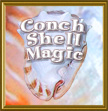
Rollin Rose, aka The Wizard of Weed
(from Weed, California)
blows 23 conch shells that resonate to the 16 minor and 7 major chakras.
Rollin is our neighbor, and when he handed me his new CD, I took a listen and then offered to redesign the cover and re-engineer the audio and put it up for sale online. Pelorian Digital now offers:
Conch Shell Magic by the Wizard of Weed
Available at Amazon

Available online, and in selected New Age book stores in Northern California and in selected Surf Shops in Southern California.
Visit the Wizard of Weed Cafe Shop to buy related paraphernalia.
Rollin discovered his talent for calibrating conch shells after White Bear, a Sioux friend, taught him to dowse for water on his desert property. Rollin got quite good at it, and figured, why not dowse for answers to questions? Several circumstances and synchronicities later he had assembled the 23 conch shells blown on this CD.
The Wizard of Weed, born in 1929, a Stanford grad and clinical psychologist who worked in the California prison system and in state mental hospitals for over 40 years, he now lives in remote Weed, California on what he has determined is the Heart Chakra portion of the giant earth ley line that vibrates through the Mt. Shasta region.
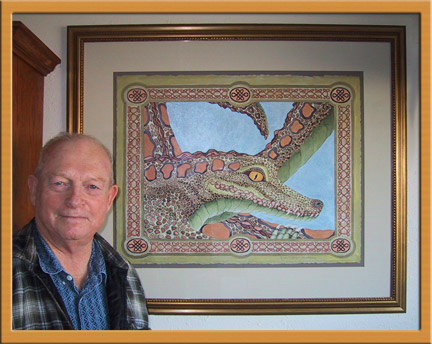
Rollin Rose with the portrait of an ally
Somewhere between hearing his Golden Mean analysis of the conch shell's resonance chamber and the powerful vibration of standing a foot away from the 3rd eye conch shell being blown, I got the impression that Rollin may be on to something. Not that conch shell blowing is anything new.
In India the sound of the conch is associated with the sacred syllable AUM, the first sound of creation. Conches that spiral clockwise are said to symbolize the expansion of infinite space. These conches belong to Lord Vishnu, the preserver god. Conches that spiral counterclockwise are said to defy the "laws of nature," and belong to the destroyer/transformation god, Lord Shiva. The conch is one of the five principle weapons of Vishnu. Followers of Vishnu believe the conch shell was given to us to destroy all evil. Arjuna, the hero of India's epic Mahabharata, blew a particularly powerful conch as a battle horn. It was said to "banish evil spirits, avert natural disasters and scare away poisonous creatures." I think the Democrats could use one of those. Lord Shiva once stole Vishnu's conch, but blew the conch so loudly that Vishnu knew immediately who had it. Shiva instantly appeared before Vishnu and explained that the conch was at his home on Mt. Kailash, but it was his son the elephant god Ganesh who had it. If Vishnu wanted the conch returned he would first have to perform a puja ceremony in honor of Ganesh. The Hindu gods are always engaged in these mythic dramas, usually for our benefit. You can hear all of these stories from India's itinerant holy men, the sadhus. When the sadhus sit around a ceremonial fire and smoke ganja in their chillum pipes, before they light up they chant, "Bom Shiva Shankara!" which means "Hail Lord Shiva the Conch Shell Blower!"
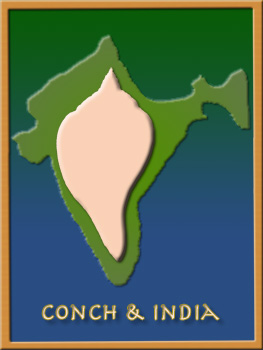
In Tibet the conch shell is used in Buddhist rituals, both blown and as a receptacle for holy water. It can also be heard as a musical instrument in a Tibetan orchestra. The conch shell was a vessel for precious oils and medicines in the Indus Valley civilization more than 4,000 years ago. Conch Shell jewelry has been recently found at Mehergarth, the ruins of a 9000 year old settlement (the oldest human settlement found to date) in what is now Pakistan. The sub-continent of India itself is in the shape of a conch.
The conch has been used ritually in other parts of Asia as well, and still today in Japan as a spiritual aid and in Korea for military fanfares.
The Minoans reputedly used the conch for rituals, and their later Greek neighbors believed Triton, the son of Amphitrite and Poseidon, blew the conch to control the magnitude of the waves.
The conch has been widely blown in the Americas, as well as traded as a commodity. Conch shells became carving tools, drinking cups, medicinal containers, jewelry and valued as sacred ceremonial objects. When Christopher Columbus landed in the New World, the Arawak natives he discovered were eating the conch regularly, and using the shell as a tool and for music and ceremonies. In a creation myth from the Aztecs, the feathered serpent god Quetzalcoatl tricks the lord of the underworld with a kind of conch shell magic.

Hawaiians use a ceremonial conch shell that can be heard as far as two miles away. The "mythical" Menehune, an ancient tiny people that are believed to have lived throughout the Hawaiian islands were considered god-like by the Polynesian settlers in Hawaii. The new settlers blew a conch shell to "control" the little gods. It is said that one time the Menehune stole the special conch and kept the Hawaiians up at nights with constant concerts, so much so that a brave Hawaiian retrieved the stolen conch. I never understood the Menehune mythology, if only because the islands are dotted with the ruins of their ancient temples, and that very conch shell from the story is currently on display in the Bishop Museum in Honolulu. How can myths have so much physical evidence? Today the "Pu," a special ceremonial conch, is used to announce the opening of the Hawaii State Legislature.
Aside from all the use we humans find, the conch shell starts out as the home for what is basically a big snail. These intelligent gastropods travel in schools and are wary of fishermen. With two eyes on long gelatinous stalks peering out into the world, they languidly feed on the ocean floor while all the time growing shells that curve in a proportion identical to the shape of spiral galaxies.
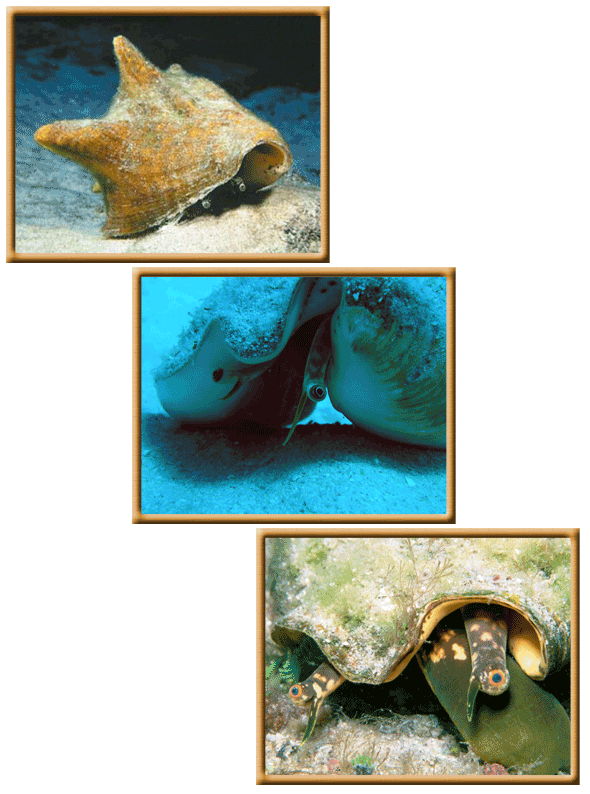
Not only is that graceful golden 1.618 proportion beautiful and beguiling, the construction of the shell itself appears to involve a high degree of expert masonry. The structure of the conch shell is currently being studied for aerospace and computer industry applications. The calcium (actually aragonite) is woven by the growth of the mollusk into a brick-and-mortar-like micro-architecture that is 1,000 times stronger than simple previously used aragonite-like ceramics.
That kind of strength and harmonious symmetry in a musical instrument gives the resonating chamber a unique audio quality. Rollin Rose uses that unusually clear and penetrating tone to create a sympathetic vibration within the human body. Like Arjuna's powerful blasts on the shell, Rollin hopes to banish evil by encouraging the vibrational strength of the body's energy centers.
When the Wizard of Weed blew one of the largest shells in his collection and my left knee vibrated, I was interested to find he had in fact blown the left knee chakra shell. After years of meditating, I am used to focusing my attention on the seven main chakras that run along the path of the spinal cord. After years of playing the Indian sitar with 20 strings of which 13 strings are not "played" at all but simply sound unstruck, I am somewhat attuned to feeling the subtle massage of sympathetic vibrations. When listening to Rollin's CD, my intuition, musical intuition if you perfer, easily associates those seven conch tones to the seven major chakras.

Artist Marlis Jermutus with the Left Knee Chakra Conch
In a circuitous way, Rollin connects his conch magic to the tradition that wielded that shell in Hawaii that so vexed the tiny Menehune. He tells me that when he dowses, he holds the divining rods and asks the questions, but it's Madame Pele, the Hawaiian volcano goddess, who answers the questions by turning the rods or not.
There's a lot that can be said and pondered about Rollin and his novel broadening of the conch tradition, but without doubt, he blows a conch with the sincerity of a jazz immortal and the authority of a native chieftain.
That guy blows a hot conch.
Enjoy.
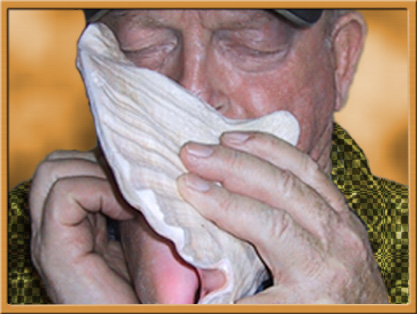
Conch Eyes Photo 1 - Copyright 2000 Jonathan Bird
Conch Eyes Photo 2 - Chris Menjou Underwater Planet
Conch Eyes Photo 3 - Copyright 2004 Eric Riesch/Marine Life Images
Hawaiian Conch Blowers thanks to Cheap Tours Hawaii
All other graphics - Copyright 2004 Pelorian Digital
